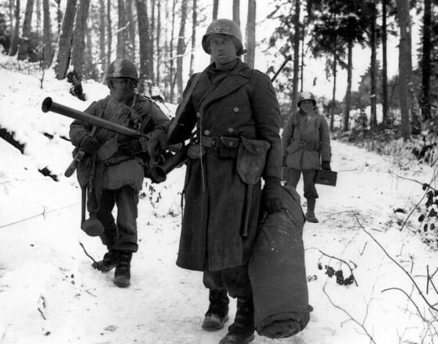16 December 1944 saw the start of the German ‘Ardennes Offensive’ (the Battle of the Bulge). It was to be the US’ biggest pitched battle in their history, involving 600,000 American troops. The Allied forces were advancing towards Germany, pushing the Germans back town by town and believing the war to be almost won. But this was Hitler’s last attempt to stop the momentum. His aim was to advance through the wooded area of the Ardennes in Luxembourg and Belgium and cut the Allied armies in two and then push on towards the port of Antwerp, a vital Allied stronghold.
 The Allies knew there was a build-up of German troops and equipment around the Ardennes but never believed Hitler was capable of such a bold initiative. Only the day before the attack, the British commander, Bernard Montgomery, told Dwight D Eisenhower, the Allies’ Supreme Commander, that the Germans would be incapable of staging ‘major offensive operations’. Captured Germans spilled the plans but their information was ignored. Thus, the attack came as a complete surprise.
The Allies knew there was a build-up of German troops and equipment around the Ardennes but never believed Hitler was capable of such a bold initiative. Only the day before the attack, the British commander, Bernard Montgomery, told Dwight D Eisenhower, the Allies’ Supreme Commander, that the Germans would be incapable of staging ‘major offensive operations’. Captured Germans spilled the plans but their information was ignored. Thus, the attack came as a complete surprise.
‘Nuts’
Thick snow and heavy fog prevented the Americans from employing their airpower and the German advance of 250,000 men forced a dent in the American line (hence battle of the ‘Bulge’). Germans, dressed in American uniforms and driving captured US jeeps, caused confusion and within five days the Germans had surrounded almost 20,000 Americans at the crossroads of Bastogne. Their situation was desperate but when the German commander gave his American equivalent, Major-General Anthony McAuliffe, the chance to surrender, McAuliffe answered with just the one word – ‘Nuts’.
US soldiers near the town of St Vith were not so lucky and 8,000 of them surrendered – the largest surrender of US troops since the American Civil War 80 years before. Elsewhere, the Germans taunted the Americans, using loudspeakers to ask, ‘How would you like to die for Christmas?’
‘Lovely weather for killing Germans’
US General George Patton appealed for divine intervention – ‘Sir, this is Patton talking’, he said, addressing God in a small Luxembourg church, ‘You have just got to make up Your mind whose side You’re on.’ On Patton’s urging, God must have made up His mind for near Christmas the fog lifted, and the Americans were able to launch their planes. Patton, considering the weather, said, ‘It’s a cold, clear Christmas – lovely weather for killing Germans’. While Patton moved reinforcements into Bastogne and relieved its desperate defenders, Montgomery prevented the Germans from crossing the River Meuse.
The Americans then counterattacked; the Germans ran out of fuel and the bulge was burst. The Ardennes Offensive did delay the Allied advance but on 22 January the Germans began their retreat and by the 28th the line was back to where it was on 16 December. But at a cost – the US lost over 80,000 men killed or wounded. Amongst the dead, were 101 unarmed American prisoners, murdered by the SS. The Germans lost over 100,000 and, vitally, much of its aircraft and tanks which, at that stage of the war, were impossible to replace. The march on Berlin was back on.
The struggle and conditions at Bastogne are brought to life in the excellent US TV mini-series Band of Brothers. There is also a 1965 film starring Henry Fonda and Terry Savalas, ‘The Battle of the Bulge’, a classic American epic where sometimes historical accuracy takes second place to entertainment but none the worse for that!
 Rupert Colley
Rupert Colley
Read more about the war in The Clever Teens Guide to World War Two available as an ebook and 80-page paperback from Amazon, Barnes & Noble, Waterstone’s, Apple Books and other stores.